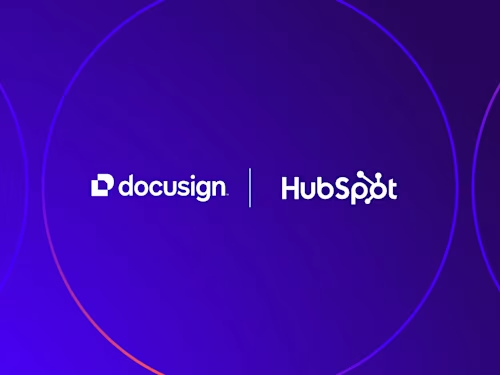
Docusign mit HubSpot verbinden
Optimieren Sie Ihre Geschäftsprozesse durch die nahtlose Integration von Docusign mit HubSpot. In diesem Leitfaden erfahren Sie, wie Sie beide leistungsstarken Plattformen verbinden und dadurch Vertragsabschlüsse beschleunigen, Workflows automatisieren und die Effizienz steigern. Die Einrichtung Ihres HubSpot-Accounts für die Docusign-Integration ist einfacher als gedacht – folgen Sie unserer Schritt-für-Schritt-Anleitung und erschließen Sie das volle Potenzial dieser strategischen Verbindung, die Marketing, Vertrieb und Vertragsmanagement intelligent miteinander verknüpft.
- Was ist HubSpot?
- Darum ist die Integration von HubSpot und Docusign sinnvoll
- Schritt-für-Schritt-Anleitung zur Integration
- Custom Fields in der Docusign-HubSpot-Integration
- Praktische Anwendungsbeispiele
- Erweiterte Integrationen: Docusign Maestro
- Video-Anleitung zur Docusign-HubSpot-Integration
- FAQ: Häufige Fragen zur Docusign-HubSpot-Integration
- Fazit: Synergien nutzen mit Docusign und HubSpot
- Entdecken Sie die Neuheiten von Docusign IAM oder starten Sie kostenlos mit eSignature
Inhaltsverzeichnis
- Was ist HubSpot?
- Darum ist die Integration von HubSpot und Docusign sinnvoll
- Schritt-für-Schritt-Anleitung zur Integration
- Custom Fields in der Docusign-HubSpot-Integration
- Praktische Anwendungsbeispiele
- Erweiterte Integrationen: Docusign Maestro
- Video-Anleitung zur Docusign-HubSpot-Integration
- FAQ: Häufige Fragen zur Docusign-HubSpot-Integration
- Fazit: Synergien nutzen mit Docusign und HubSpot
- Entdecken Sie die Neuheiten von Docusign IAM oder starten Sie kostenlos mit eSignature

Was ist HubSpot?
HubSpot ist eine integrierte Plattform für Marketing, Vertrieb und Kundenservice, die Unternehmen dabei unterstützt, ihre Inbound-Marketingstrategien zu optimieren. Gegründet im Jahr 2006, hat sich HubSpot zu einer führenden Lösung für Unternehmen aller Größen entwickelt. Die Plattform bietet eine breite Palette von Tools und Funktionen zur Automatisierung von Marketingkampagnen, Verbesserung von Vertriebsprozessen und besseren Erfüllung von Kundenwünschen.
Das Herzstück von HubSpot ist das Customer Relationship Management (CRM)-System, das als zentrale Datenbank für alle Kundeninteraktionen dient. Mit den 2025 eingeführten Funktionen können Sie jetzt drag-and-drop-anpassbare Widgets nutzen, um Dashboards mit relevanten Leistungskennzahlen zu erstellen. Im rechten Bedienfeld können Sie verschiedene Datenvisualisierungen auswählen und anpassen. Das CRM ermöglicht die Verwaltung von Kontakten, Nachverfolgung von Interaktionen und Erstellung personalisierter Marketingkampagnen. Die Automatisierungstools bieten fortschrittliche Workflow-Funktionen mit mehrstufigen, adaptiven Automatisierungssequenzen.
Die Integration von HubSpot mit verschiedenen Drittanbieter-Tools, wie beispielsweise Docusign oder Salesforce, erweitert die Funktionalität der Plattform erheblich und ermöglicht nahtlose Übergänge zwischen verschiedenen Geschäftsprozessen.
Hat HubSpot eine eigene E-Signatur-Funktion?
Ja, HubSpot verfügt über eine eigene E-Signatur-Funktion, die seit 2025 von Dropbox Sign (früher HelloSign) unterstützt wird. Diese Funktion ist in den Quotes-Tools der Sales Hub Professional- und Enterprise-Pläne integriert. Sie können damit grundlegende Signaturprozesse direkt in HubSpot durchführen. Für fortgeschrittenere Anforderungen wie mehrere Unterzeichner, benutzerdefinierte Workflows oder Dokumentenautomatisierung empfiehlt sich jedoch die Integration mit Docusign eSignature, die umfassendere Funktionen und eine robustere Vertragsmanagement-Infrastruktur bietet.
Darum ist die Integration von HubSpot und Docusign sinnvoll
HubSpot ist eine führende Plattform für Marketingautomatisierung, Kundenservice und Vertrieb, während Docusign sich auf elektronische Signaturen und Vertragsmanagement spezialisiert hat. Durch die Verbindung dieser beiden Plattformen können Sie Daten nahtlos zwischen Marketing, Vertrieb und Vertragsprozessen austauschen.
Effiziente Leadgenerierung: Mit der HubSpot Integration können Sie automatisch Leads aus Docusign in Ihren HubSpot Account importieren. Wenn Interessenten einen Vertrag mit Docusign unterzeichnen, werden die relevanten Informationen direkt in Ihr HubSpot-Konto übertragen. Unternehmen berichten von bis zu 40% schnelleren Reaktionszeiten auf neue Leads durch diese automatische Datenübertragung, was die Abschlussraten messbar steigert.
Personalisierte Kommunikation: Durch die Integration von Docusign-Informationen in HubSpot können Sie Ihre Kunden genau dort abholen, wo sie sich gerade befinden. Senden Sie automatisch Follow-up-E-Mails oder Marketingmaterial basierend auf Vertragsaktionen. Aktuelle Daten zeigen, dass personalisierte, automatisierte Follow-ups die Conversion-Rate um durchschnittlich 35% im Vergleich zu standardisierten Kampagnen erhöhen.
Effektives Vertragsmanagement: Mit der Create-Customize-Funktion erstellen und versenden Sie Verträge direkt aus HubSpot heraus. Der gesamte Vertragsprozess, einschließlich Unterzeichnung und Tracking, kann in einem zentralen System verwaltet werden. Kunden wie KARIMI.legal berichten von Zeiteinsparungen von bis zu 30 Minuten pro Fall, was sich bei hohem Vertragsvolumen auf Hunderte von Stunden summieren kann.
Die Integration von HubSpot und Docusign stellt nicht nur eine technische Verbindung dar, sondern einen fundamentalen Wandel in der Arbeitsweise von Unternehmen. Durch die Automatisierung von Routineaufgaben und die nahtlose Datenübertragung direkt in Ihre Docusign-Prozesse beschleunigen Sie nicht nur Ihre Vertriebszyklen, sondern steigern auch nachweislich Ihren Umsatz – Studien zeigen, dass Unternehmen mit integrierter CRM-Vertragslösung durchschnittlich 15% höhere Abschlussraten erzielen.
Schritt-für-Schritt-Anleitung zur Integration
Schritt 1: Vorbereitung und Anmeldung
Halten Sie Ihre Zugangsdaten für HubSpot und Docusign bereit. Stellen Sie sicher, dass Sie in HubSpot über die Rolle des Super Admins verfügen oder über die erforderlichen App Marketplace-Berechtigungen verfügen, um Integrationen konfigurieren zu können. Loggen Sie sich in beide Konten ein, um den Integrationsprozess zu starten.
Schritt 2: Zugang zum App Marketplace
Klicken Sie in Ihrem HubSpot-Dashboard auf das Marketplace-Symbol in der Hauptnavigationsleiste und wählen Sie "App Marketplace" aus. Verwenden Sie die Suchleiste und geben Sie "Docusign" ein, um die Docusign-Integration zu finden. Klicken Sie dann auf den "App installieren"-Button in der oberen rechten Ecke. Sie werden anschließend zur Anmeldung in Ihrem Docusign-Konto aufgefordert.
Schritt 3: Konten verbinden
Folgen Sie den Anweisungen auf dem Bildschirm, um Ihr Docusign-Konto zu authentifizieren. Nach erfolgreicher Authentifizierung werden Sie automatisch zur Seite "Verbundene Apps" in HubSpot weitergeleitet. Hier können Sie sehen, dass die Integration installiert wurde. Klicken Sie auf "Weiter", um fortzufahren.
Erforderliche Berechtigungen | Optionale Berechtigungen |
Super Admin in HubSpot oder App Marketplace-Zugriff | Import-Berechtigungen für historische Umschläge |
Docusign-Administratorzugriff | Benutzerdefinierte Berichterstellung |
Zugriff auf Vorlagen in Docusign | Workflow-Automatisierungszugriff |
Kontakt- oder Deal-Zugriff in HubSpot | Benutzerdefinierte Feldkartierung |
Schritt 4: Konfiguration der Integrationseinstellungen
Nachdem die Verbindung hergestellt wurde, können Sie die Integrationseinstellungen anpassen. Navigieren Sie zu "Einstellungen" > "Integrationen" > "Verbundene Apps" und klicken Sie auf "Zu den Einstellungen". Legen Sie fest, welche Informationen zwischen HubSpot und Docusign synchronisiert werden sollen. Besonders wichtig ist die Konfiguration der Feldkartierung, damit Kontakt-, Unternehmens- oder Deal-Eigenschaften in Docusign-Umschlägen verwendet werden können.
Schritt 5: Workflows erstellen
Nutzen Sie die Workflow-Tools in HubSpot, um automatisierte Aktionen zu erstellen. Wählen Sie im Workflow-Aktionsmenü "Docusign-Umschlag senden" aus und definieren Sie dann den Benutzer und die Vorlage. Sie können beispielsweise automatisch E-Mails senden, wenn ein Vertrag in Docusign unterzeichnet wurde, oder bestimmte Aufgaben für Ihr Vertriebsteam auslösen, sobald Envelopes von einem Kontakt bearbeitet wurden.
Schritt 6: Test durchführen
Führen Sie einen Test durch, um sicherzustellen, dass die Integration reibungslos funktioniert. Erstellen Sie einen Dummy-Vertrag in Docusign oder senden Sie einen Testumschlag direkt aus HubSpot. Navigieren Sie dazu zu einem Kontakt-, Unternehmens- oder Deal-Datensatz, klicken Sie auf die Docusign-Sektion im rechten Bereich und wählen Sie "Von Vorlage senden". Überprüfen Sie anschließend, ob die relevanten Daten korrekt übertragen wurden.
Schritt 7: Workflows optimieren und erweitern
Nach erfolgreicher Integration können Sie Ihre Workflows weiter optimieren. Automatisieren Sie Prozesse, erstellen Sie benutzerdefinierte Berichte und passen Sie Ihre Workflows an die spezifischen Anforderungen Ihres Unternehmens an. Nutzen Sie die Möglichkeit, den Status von Umschlägen direkt in HubSpot zu verfolgen, um Ihren Vertriebsprozess effizienter zu gestalten und schneller auf Kundenanfragen reagieren zu können.
Custom Fields in der Docusign-HubSpot-Integration
Die Integration zwischen Docusign und HubSpot bietet zahlreiche Möglichkeiten zur Automatisierung von Vertragsprozessen. Wenn es jedoch um benutzerdefinierte Felder geht, gibt es einige wichtige Einschränkungen und Lösungsansätze, die Sie kennen sollten.
Standardfelder vs. Custom Fields
In der aktuellen Integration können nicht alle benutzerdefinierten HubSpot-Felder nahtlos in Docusign-Vorlagen verwendet werden. Tatsächlich ist die Auswahl auf vordefinierte Felder beschränkt, die mit "HS" beginnen und im Bereich "Custom Fields" in Docusign zu finden sind. Diese Einschränkung bedeutet, dass Sie keine beliebigen HubSpot-Eigenschaften in Ihre Vertragsvorlagen einfügen können, sondern auf die vordefinierten Felder aus den Bereichen Kontakt, Unternehmen oder Deal angewiesen sind.
Um zu überprüfen, welche Eigenschaften mit welchen Feldern verknüpft sind, navigieren Sie in HubSpot zu: Einstellungen > Connected Apps > Actions > Go to Settings > Mapped fields. Hier können Sie einsehen, welche Docusign-Felder mit welchen HubSpot-Eigenschaften verbunden sind.
Best Practices
Obwohl echte benutzerdefinierte Felder derzeit nicht vollständig unterstützt werden, gibt es praktische Workarounds:
Nutzen Sie die vorhandenen Standardfelder optimal aus und passen Sie Ihre Datenstruktur entsprechend an.
Erstellen Sie Ihre Vorlagen in Docusign und platzieren Sie die Felder dort, bevor Sie sie in HubSpot verwenden.
Verwenden Sie für komplexere Anforderungen die Create-Customize-Funktion, um Verträge vor dem Versand anzupassen.
Für besonders anspruchsvolle Szenarien kann die Aktivierung der "Document Custom Field"-Funktion in Ihrem Docusign-Konto hilfreich sein – kontaktieren Sie hierfür den Docusign-Support.
Die Entwicklung schreitet voran, und es ist zu erwarten, dass in Zukunft mehr Flexibilität bei der Verwendung benutzerdefinierter Felder in der Docusign-HubSpot-Integration möglich sein wird.
Praktische Anwendungsbeispiele
Es gibt viele Möglichkeiten, wie Sie die HubSpot-Docusign-Integration bestmöglich für sich nutzen können. Wir haben die drei beliebtesten Beispiele für Sie zusammengestellt.
1. Automatisierter Versand
Nutzen Sie die Integration, um Verträge automatisch aus HubSpot zu generieren und an relevante Leads zu senden. Erstellen Sie Vorlagen in Docusign mit HubSpot-Datenfeldern, die mit "HS" beginnen und in der Sektion "Custom Fields" zu finden sind. Wenn ein Deal eine bestimmte Phase erreicht, können Sie durch Workflows den Vertrag automatisch an den zugehörigen Kontakt senden. Verfolgen Sie den gesamten Prozess und erhalten Sie Einblicke in die Interaktionen Ihrer Leads mit den Dokumenten.
2. Dynamische Anpassung
Integrieren Sie Docusign-Unterschrifteninformationen in Ihr HubSpot-Konto, um Marketingmaterial automatisch an die spezifischen Bedürfnisse Ihrer Kunden anzupassen. Sobald ein Vertrag unterzeichnet wird, können Sie personalisierte Follow-up-Kampagnen starten, die auf dem Vertragsinhalt basieren. Die Synchronisierung der Daten zwischen beiden Plattformen ermöglicht es Ihnen, relevante Inhalte zu liefern, die auf den tatsächlichen Vertragsinteraktionen basieren.
3. Echtzeit-Updates im HubSpot CRM
Verfolgen Sie Änderungen in Docusign, um stets über den aktuellen Status von Verträgen informiert zu sein. Sobald ein Vertrag unterzeichnet wird, wird der Name eines Datensatzes in HubSpot automatisch aktualisiert, und das signierte PDF wird direkt mit dem ursprünglichen Datensatz verknüpft. Dies fördert eine effektive Zusammenarbeit zwischen Vertrieb und Vertragsmanagement und ermöglicht schnellere Reaktionszeiten auf Kundenaktionen.
Use Case | Key Workflow | KPI Impact |
Vertragsautomatisierung | Deal-Status-Änderung löst Docusign-Versand aus | 90% weniger Zeitaufwand beim Erstellen neuer Kaufverträge |
Kundenspezifische Kommunikation | Signierte Verträge lösen personalisierte E-Mail-Sequenzen aus | 42% höhere Engagement-Rate bei Follow-up-Kampagnen |
Vertriebseffizienz | Automatische Statusaktualisierung nach Vertragsunterzeichnung | 30% schnellere Durchlaufzeiten im Vertriebszyklus |
Erweiterte Integrationen: Docusign Maestro
Docusign Maestro HubSpot
DocuSign Maestro erweitert die Grundfunktionen von eSignature mit leistungsstarken Workflow-Automatisierungen für HubSpot-Nutzer. Im Gegensatz zu den Konkurrenzprodukten ermöglicht Maestro die Erstellung selbstverwalteter Vereinbarungsworkflows, die nahtlos mit HubSpot und anderen Drittanbieteranwendungen zusammenarbeiten. Die Stärke von Maestro liegt in der Automatisierung komplexer Prozesse ohne Programmieraufwand, was es besonders wertvoll für Unternehmen macht, die ihre Vertragsprozesse vollständig in ihre CRM-Strategie integrieren möchten.
Video-Anleitung zur Docusign-HubSpot-Integration
Erfahren Sie, wie Sie die Integration von Docusign und HubSpot durch eine visuelle Schritt-für-Schritt-Anleitung noch besser verstehen können. In unserem offiziellen Tutorial-Video zeigen wir Ihnen alle wichtigen Funktionen der Integration – vom ersten Verbindungsaufbau über die Konfiguration der Workflow-Einstellungen bis hin zur praktischen Anwendung im Alltag.
Das Video demonstriert anschaulich, wie Sie Verträge direkt aus HubSpot erstellen, personalisieren und zur Signatur senden können. Sie erhalten Einblicke in Best Practices und Tipps von Experten, die Ihnen helfen, das Maximum aus der Integration herauszuholen. Besuchen Sie den offiziellen Docusign YouTube-Kanal, um auf diese wertvolle Ressource zuzugreifen und Ihre Integration in kürzester Zeit erfolgreich einzurichten.
FAQ: Häufige Fragen zur Docusign-HubSpot-Integration
Kann man Docusign mit HubSpot integrieren?
Ja, Docusign lässt sich nahtlos mit HubSpot verbinden. Die Integration ermöglicht es, Verträge direkt aus HubSpot zu erstellen, zu senden und zu verfolgen. Nutzer können Signaturen überwachen, Erfolge und Misserfolge automatisch in HubSpot erfassen und signierte PDFs direkt mit den ursprünglichen Datensätzen verknüpfen, was zu einem durchgängigen Vertrags- und CRM-Workflow führt.
Was sind die Nachteile von Docusign?
Docusign-Pläne haben Limitationen bei der monatlichen Dokumentenanzahl, was bei hohem Vertragsvolumen zu Mehrkosten führen kann. Für einige Unternehmen kann die Preisstruktur pro Benutzer bei größeren Teams kostspielig werden. Zudem benötigen fortgeschrittene Funktionen wie automatisierte Workflows oder komplexe Integrationen oft Premium-Abonnements und anfängliches technisches Know-how zur Einrichtung.
Hat HubSpot eine eigene E-Signatur-Funktion?
HubSpot bietet eine integrierte E-Signatur-Funktion an, die von Dropbox Sign unterstützt wird. Diese Funktion ermöglicht elektronische Unterschriften direkt bei Angeboten und hat dieselbe rechtliche Bedeutung wie handschriftliche Unterschriften. Die Nutzung wird pro Signaturvorgang auf das Kontolimit angerechnet, unabhängig von der Anzahl der Unterzeichner. Für komplexere Anforderungen empfiehlt sich jedoch die Docusign-Integration.
Kann man Docusign automatisieren?
Absolut, Docusign bietet umfangreiche Automatisierungsmöglichkeiten. Mit vorgefertigten Integrationen für über 400 Business-Systeme können Workflows für Dokumentensignaturen problemlos eingerichtet werden. Die Plattform ermöglicht benutzerdefinierte Workflows zur Automatisierung der Vertragserstellung, der Genehmigungen und des Abschlusses von Vereinbarungen – ohne Programmierung und mit voller Kontrolle über den gesamten Prozess.
Fazit: Synergien nutzen mit Docusign und HubSpot
Die Integration von HubSpot und Docusign ist eine intelligente Lösung, um Geschäftsprozesse zu optimieren und die Effizienz deutlich zu steigern. Durch die nahtlose Verbindung von Marketing, Vertrieb und Vertragsmanagement können Sie den gesamten Kundenlebenszyklus besser verwalten und Ihr Vertragsmanagement erheblich beschleunigen.
Für fortgeschrittenere Anforderungen können Sie Docusign IAM auswählen, um noch umfassendere Automatisierungsfunktionen zu nutzen. Besuchen Sie auch den HubSpot App Marketplace, um weitere Integrationen und Funktionen zu entdecken, die Ihr Geschäft weiter voranbringen.
Testen Sie Docusign 30 Tage lang kostenlos Kostenlos testen
Entdecken Sie die Neuheiten von Docusign IAM oder starten Sie kostenlos mit eSignature
Ähnliche Beiträge
Docusign IAM ist die Vertragsplattform, die Ihr Unternehmen braucht



